library(tidyverse)
# ── Attaching core tidyverse packages ──────────── tidyverse 2.0.0 ──
# ✔ dplyr 1.1.4 ✔ readr 2.1.5
# ✔ forcats 1.0.0 ✔ stringr 1.5.1
# ✔ ggplot2 3.5.1 ✔ tibble 3.2.1
# ✔ lubridate 1.9.4 ✔ tidyr 1.3.1
# ✔ purrr 1.0.2
# ── Conflicts ────────────────────────────── tidyverse_conflicts() ──
# ✖ dplyr::filter() masks stats::filter()
# ✖ dplyr::lag() masks stats::lag()
# ℹ Use the conflicted package (<http://conflicted.r-lib.org/>) to force all conflicts to become errors
rta <- read_delim("./data/session5/RTAIS_inforce_inactive.csv", ";", escape_double = FALSE, trim_ws = TRUE, skip = 3)
# Rows: 74 Columns: 6
# ── Column specification ────────────────────────────────────────────
# Delimiter: ";"
# dbl (6): Year of entry into force, Notifications of RTAs in forc...
#
# ℹ Use `spec()` to retrieve the full column specification for this data.
# ℹ Specify the column types or set `show_col_types = FALSE` to quiet this message.
rta <- rta[-1, ]
rta <- rta[ , 1:3]
colnames(rta)[1] <- "year"
rta <- rta %>% pivot_longer(!year, names_to = "indicator", values_to = "value")
dt <- rta
# Visualization of RTAs over time
library(plotly)
#
# Attaching package: 'plotly'
#
# The following object is masked from 'package:ggplot2':
#
# last_plot
#
# The following object is masked from 'package:stats':
#
# filter
#
# The following object is masked from 'package:graphics':
#
# layout
library(RColorBrewer)
library(crosstalk)
library(ggsci)
df <- SharedData$new(dt)
# Create color palette
mycolor <- pal_uchicago("default")(9)
mycolor <- mycolor[1:length(unique(df$data()$indicator))]
colorfunc <- colorRampPalette(mycolor)
nbcolor <- length(unique(df$data()$indicator))
colorPalette <- colorfunc(nbcolor)
logoLink <- "https://avatars1.githubusercontent.com/u/26974715?s=400&u=d86c8a0a761e67fa2c4c2a881d4d2e6b503082d0&v=4"
if (knitr::is_html_output()) {
# Interactive filters
widgets <- bscols(
widths = c(12, 12),
filter_select("indicator", "Indicator", df, ~indicator),
filter_slider("year", "Years", df, ~year, step=1, sep="")
)
# Stacked bar chart of RTAs in force vs inactive
bscols(
plot_ly(df, x=~year, y=~value) %>%
add_trace(type='bar', color=~indicator, colors=colorPalette, legendgroup=~indicator, showlegend=TRUE) %>%
config(displaylogo = FALSE, collaborate = FALSE,
modeBarButtonsToRemove = list('sendDataToCloud','resetScale2d',
"pan2d","zoomIn2d","zoomOut2d")) %>%
layout(barmode="stack",
xaxis = list(title = ""),
yaxis = list(title = paste0(substr(unique(df$data()$indicator), 1, 25), "...")),
images = list(
list(source = logoLink, xref="paper", yref="paper",
xanchor="center", yanchor="center",
x=0.5, y=1.072, sizex=0.16, sizey=0.16)
),
legend = list(orientation = 'h', x=0.5, xanchor='center', yanchor='top'),
annotations = list(list(x = 1, y = -0.1, text = "Source: World Trade Organization", showarrow = FALSE,
xref='paper', yref='paper', xanchor='right', yanchor='auto',
font=list(size=12))),
height=500, autosize=TRUE
)
)
} else {
# Static plot for non-HTML output
ggplot(dt, aes(x = year, y = value, fill = indicator)) +
geom_bar(stat = "identity", position = "stack") +
scale_fill_manual(values = colorPalette) +
labs(title = "Regional Trade Agreements in Force and Inactive",
x = "Year",
y = "Number of RTAs") +
theme_minimal() +
theme(legend.position = "bottom")
}
# Warning in bscols(widths = c(12, 12), filter_select("indicator",
# "Indicator", : Sum of bscol width units is greater than 12
# Warning in config(., displaylogo = FALSE, collaborate = FALSE,
# modeBarButtonsToRemove = list("sendDataToCloud", : The collaborate
# button is no longer supported
# Warning: Specifying width/height in layout() is now deprecated.
# Please specify in ggplotly() or plot_ly()
# Warning: 'config' objects don't have these attributes: 'collaborate'
# Valid attributes include:
# 'autosizable', 'displaylogo', 'displayModeBar', 'doubleClick', 'doubleClickDelay', 'editable', 'edits', 'fillFrame', 'frameMargins', 'globalTransforms', 'linkText', 'locale', 'locales', 'logging', 'mapboxAccessToken', 'modeBarButtons', 'modeBarButtonsToAdd', 'modeBarButtonsToRemove', 'notifyOnLogging', 'plotGlPixelRatio', 'plotlyServerURL', 'queueLength', 'responsive', 'scrollZoom', 'sendData', 'setBackground', 'showAxisDragHandles', 'showAxisRangeEntryBoxes', 'showEditInChartStudio', 'showLink', 'showSendToCloud', 'showSources', 'showTips', 'staticPlot', 'toImageButtonOptions', 'topojsonURL', 'typesetMath', 'watermark'18 The WTO and Regional Trade Agreements (RTAs)
This chapter provides a comprehensive and conceptually grounded treatment of the relationship between the multilateral trading system governed by the World Trade Organization (WTO) and the proliferation of regional trade agreements (RTAs). It proceeds in five steps. First, it reconstructs the legal and institutional architecture of the General Agreement on Tariffs and Trade (GATT) and the WTO, emphasizing the fundamental principles—most-favored-nation treatment and national treatment—and the carefully delimited exceptions under which RTAs are permitted. Second, it documents the global rise of RTAs since 1948 and interprets that trajectory in light of contemporary theory and evidence in International Political Economy (IPE), including work on “domino regionalism,” deep versus shallow integration, and the political economy of rule design (Baldwin, 2011; Dür, Baccini, & Elsig, 2014; Horn, Mavroidis, & Sapir, 2010). Third, it reviews the classic “building blocks versus stumbling blocks” debate through the lenses of trade creation and diversion, endogenous protection, and multilateralization, synthesizing the empirical record (Viner, 1950; Bhagwati, 1993; Freund & Ornelas, 2010; Subramanian & Wei, 2007). Fourth, it analyzes the implications of RTAs for multinational enterprises (MNEs), global value chains (GVCs), and foreign direct investment (FDI), connecting the design of “deep” provisions to firms’ organization of production and cross-border investment (Antràs & Staiger, 2012; Osnago, Rocha, & Ruta, 2018; Mattoo, Rocha, & Ruta, 2020). Fifth, it develops regional case studies—North America, Europe, Latin America, Africa, and Asia—linking legal form, economic outcomes, and ongoing governance challenges, and it closes by considering whether, how, and when RTAs can complement rather than fragment the multilateral order (Hoekman & Mavroidis, 2015; Baldwin & Low, 2009).
Throughout, the exposition employs a formal academic register and uses APA-style in-text citations. Where appropriate, the chapter integrates reproducible code chunks that load, transform, and visualize data or maps, allowing the reader to replicate figures in an applied or classroom setting. The code is intentionally separated from the prose to ensure that the word count refers solely to the narrative text.
18.1 The GATT/WTO Architecture: Principles and Carefully Delimited Exceptions
The modern multilateral trading system rests on two cardinal principles. The most-favored-nation (MFN) obligation requires that any advantage granted by a WTO member to the goods or services of another member be extended immediately and unconditionally to the like products or services of all members (GATT Article I; GATS Article II). In parallel, the national treatment obligation mandates that once foreign goods or services have cleared customs or entered a market, they must be treated no less favorably than their domestic counterparts (GATT Article III; GATS Article XVII). This combination of symmetry across trading partners at the border and nondiscrimination behind the border underwrites the predictability of market access that has historically disciplined unilateral protection and tit-for-tat retaliation (Jackson, 1997; Hoekman & Kostecki, 2009).
At the same time, MFN is not absolute. The GATT included, from the outset, controlled exceptions permitting customs unions and free-trade areas—regional arrangements that liberalize “substantially all the trade” among their members—provided such arrangements do not, on the whole, raise barriers against third countries (GATT Article XXIV). For developing economies, the 1979 Decision on Differential and More Favourable Treatment, commonly known as the “Enabling Clause,” institutionalized the Generalized System of Preferences (GSP) and authorized preferential trade agreements among developing country members on more flexible terms. In services, Article V of the General Agreement on Trade in Services (GATS) allows for economic integration agreements that have substantial sectoral coverage and provide an absence or elimination of substantially all discrimination (WTO, 2011). In each instance, the legal accommodation of regionalism is conditional: it recognizes that deeper integration among a subset of countries may advance welfare and development while guarding against disguised protectionism directed at outsiders (Hoekman & Mavroidis, 2015).
The WTO has developed procedural disciplines to operationalize these exceptions. A transparency mechanism adopted in 2006 requires members to notify RTAs, facilitates factual presentations by the Secretariat, and provides a forum for peer review (WTO, 2011). These procedural innovations respond to the reality that regionalism has become ubiquitous while the membership continues to affirm that multilateral rules remain the default anchor for non-discriminatory trade. As such, the legal “nesting” of RTAs within the WTO aims to reconcile the permissibility of preferential integration with preservation of the core multilateral commitments (Bagwell & Staiger, 2002; Horn et al., 2010).
Restatement. When a member grants more favorable conditions to RTA partners than to other members, it departs from MFN; hence WTO law insists that such agreements be comprehensive in coverage and non-worsening toward third parties. In practical terms, the system recognizes regionalism as a conditional exception to non-discrimination, not as a wholesale substitute.
18.2 The Proliferation of RTAs since 1948: Descriptive Patterns and Stylized Facts
The explosion of RTAs since the late 1980s is by now a stylized fact. Following early postwar experiments (e.g., the European Economic Community and the European Free Trade Association), the number of RTAs accelerated with the “new regionalism” era, overlapping with the Uruguay Round and the creation of the WTO (Ethier, 1998; Baldwin, 2011). The historical series reveals three salient features. First, the cumulative number of notified RTAs in force displays a persistent upward trend, with a marked inflection in the 1990s. Second, the composition of agreements has shifted from shallow tariff-cutting accords to “deep” agreements encompassing services, investment, intellectual property, competition, procurement, and regulatory cooperation (Horn et al., 2010; Hofmann, Osnago, & Ruta, 2017). Third, regionalism is now global: high-income, emerging, and least developed economies participate, often with multiple memberships, producing the well-known “spaghetti bowl” of overlapping commitments (Bhagwati, 1995; Dür et al., 2014).
The following reproducible code ingests a WTO-derived dataset and visualizes the growth in RTAs in force and inactive across time.
The maps below provide a static complement, depicting participation intensity and the global distribution of agreements.
knitr::include_graphics("./figures/session5/fig1.png")
Source: WTO participation map. Darker shades indicate higher RTA participation.
knitr::include_graphics("./figures/session5/fig2.png")
Source: WTO.
The typology of RTAs also reveals the heterogeneity of instruments deployed across regions.
knitr::include_graphics("./figures/session5/fig3.png")
© 2013 Cengage Learning. All rights reserved.
knitr::include_graphics("./figures/session5/fig4.png")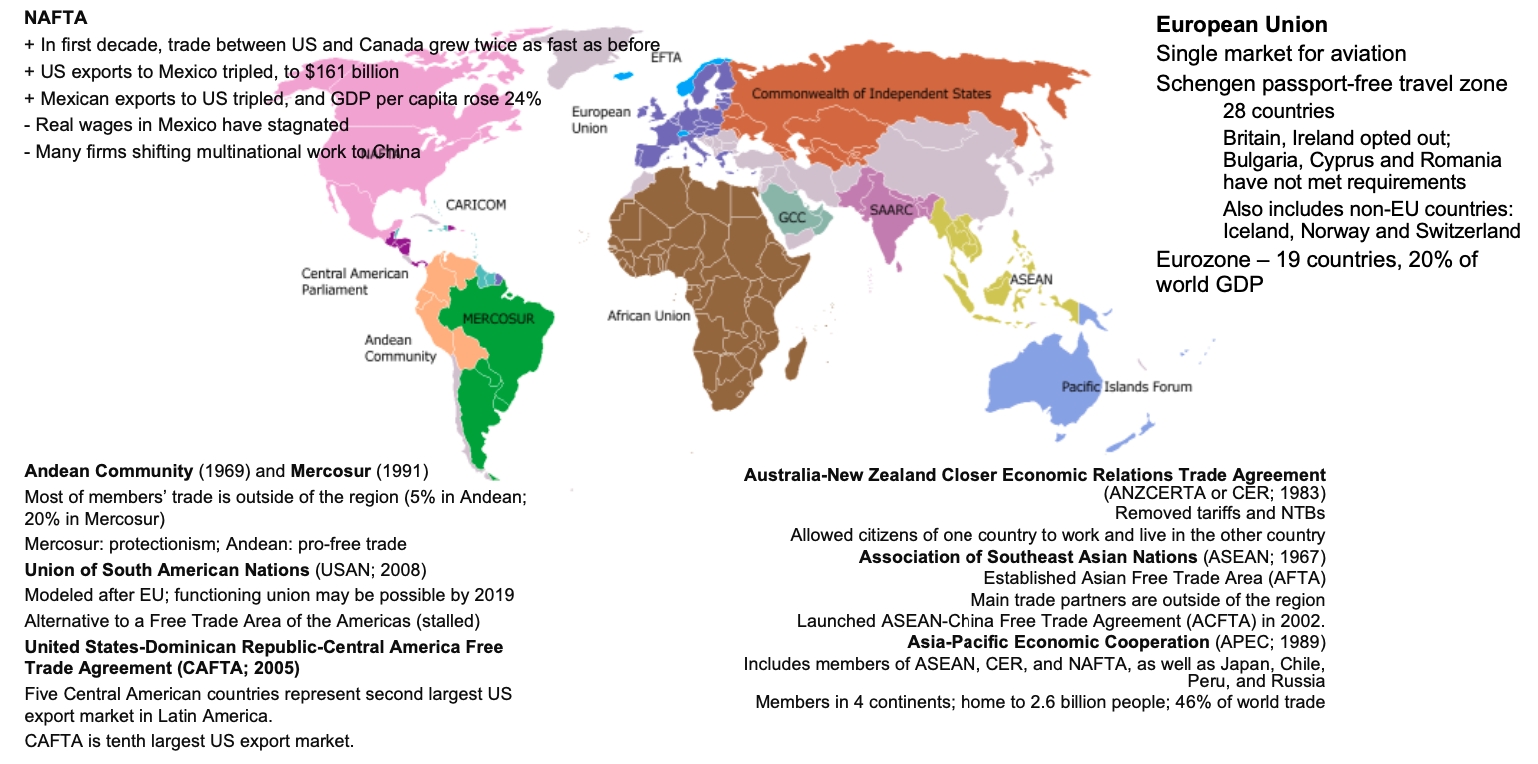
Synopsis of RTA variety and core features.
18.3 Economic Logic: Building Blocks, Stumbling Blocks, and the Multilateral Interface
From the vantage of canonical trade theory, the welfare and system effects of a preferential agreement turn on the balance between trade creation and trade diversion (Viner, 1950). Trade creation occurs when liberalization induces substitution toward lower-cost producers within the bloc, raising real income. Trade diversion emerges when preferences shift sourcing from a more efficient external supplier to a higher-cost partner solely due to the discriminatory tariff wedge, potentially reducing welfare. These partial equilibrium intuitions carry through to general equilibrium settings, with the caveat that dynamic effects—integration-induced scale, competition, and innovation—can magnify benefits, while complex rules of origin (ROOs) and carve-outs can magnify costs (Krugman, 1991; Freund & Ornelas, 2010; Cadot & de Melo, 2008).
The policy question is not merely whether an RTA raises or lowers the ex post welfare of its members, but whether the cumulative spread of RTAs advances or undermines the multilateral order. One camp views regionalism as a “building block,” either because it delivers liberalization that multilateral bargaining cannot achieve or because competitive liberalization triggers a “domino effect” in which outsiders seek entry or match concessions to avoid preference erosion (Bhagwati, 1993; Baldwin, 1997, 2011). A second camp is more guarded, emphasizing the spaghetti bowl of overlapping commitments, the administrative burden of ROOs, and the political economy risk that insiders develop vested interests in maintaining discrimination, thereby weakening multilateral disciplines (Bhagwati, 1995; Limão, 2006). A third, empirical strand stresses heterogeneity: RTAs vary immensely in depth, coverage, and institutional quality, so their systemic effects are conditional (Dür et al., 2014; Hofmann et al., 2017).
The evidence is nuanced. Early econometric work found that WTO membership had heterogeneous effects on trade, reflecting differences in bindings and participation (Rose, 2004), while later studies concluded that the GATT/WTO increased trade substantively by anchoring commitments and disciplining contingent protection (Subramanian & Wei, 2007; Eicher & Henn, 2011). For regionalism, meta-analyses suggest that many RTAs do expand bilateral trade among members, with estimated effects larger for “deep” agreements that include behind-the-border disciplines (Head & Mayer, 2014; Hofmann et al., 2017; Mattoo et al., 2020). At the same time, welfare impacts depend on ROO restrictiveness, sectoral exclusions, and compatibility with multilateral norms (Cadot & de Melo, 2008; Estevadeordal & Suominen, 2008).
The figure below illustrates indicative classifications some studies have reported: certain small preferential schemes have behaved as building blocks, while others have exhibited greater diversionary risk; large, expanding agreements often show initial gains that attenuate if additional members come with complex rule heterogeneity. The key takeaway is not a single verdict but a design principle: breadth, depth, and transparency tend to correlate with positive outcomes, whereas narrow and highly restrictive preferences elevate diversion risk (Freund & Ornelas, 2010; Horn et al., 2010).
18.4 From Shallow to Deep Integration: Design, Rules of Origin, and Regulatory Cooperation
The last three decades have seen a transition from shallow agreements focused on border measures to deep agreements that regulate policies inside the border. Deep RTAs typically incorporate disciplines on investment, services, technical barriers to trade (TBT), sanitary and phytosanitary measures (SPS), competition policy, state-owned enterprises, intellectual property, government procurement, and—more recently—digital trade (Horn et al., 2010; Hofmann et al., 2017; Mattoo et al., 2020). This design shift reflects both economics and politics. Economically, value chains fragment production across jurisdictions, making behind-the-border policies key determinants of trade costs. Politically, countries have used RTAs as laboratories for rule-making that has proven difficult to achieve multilaterally.
Rules of origin are the linchpin connecting preferential market access to industrial organization. ROOs determine which goods qualify for preferences; their restrictiveness shapes sourcing decisions, the extent of cumulation across members, and the administrative burden placed on firms (Cadot & de Melo, 2008; Estevadeordal & Suominen, 2008). Restrictive ROOs can neutralize the margin of preference and generate costly trade diversion toward intermediate inputs within the bloc even if external suppliers are more efficient. Conversely, modern cumulation provisions—diagonal or full cumulation across multiple RTAs—can align ROOs with the geographic reality of value chains, mitigating costs and facilitating “multilateralization” of preferences (Baldwin & Low, 2009; Antràs & Staiger, 2012).
The presence of complementary provisions matters. Investment protections, disciplines on data and cross-border services, and mutual recognition in standards can lower fixed costs of operating regionally, encouraging MNEs to embed production within the bloc. Pro-competitive procurement rules and limits on performance requirements can amplify these effects. Conversely, carve-outs, security exceptions, and weak dispute settlement reduce credibility and limit firms’ willingness to treat an RTA as an institutional substitute for multilateral certainty (Hoekman & Mavroidis, 2015; Mattoo et al., 2020).
The debate over “mega-regionals”—large, advanced-economy agreements such as trans-Pacific or trans-Atlantic initiatives—has often centered on whether such accords function as rule creators with positive spillovers or as exclusive clubs that fragment standards. The answer turns on openness and replicability: if deep disciplines are drafted to be transparent, non-exclusionary, and available for accession, they can diffuse and raise global baselines; if they lock in club goods, they risk bifurcating regimes (Baldwin, 2011; Dür et al., 2014).
The following figure (from course materials) raises the evaluative question explicitly.
knitr::include_graphics("./figures/session5/fig5.png")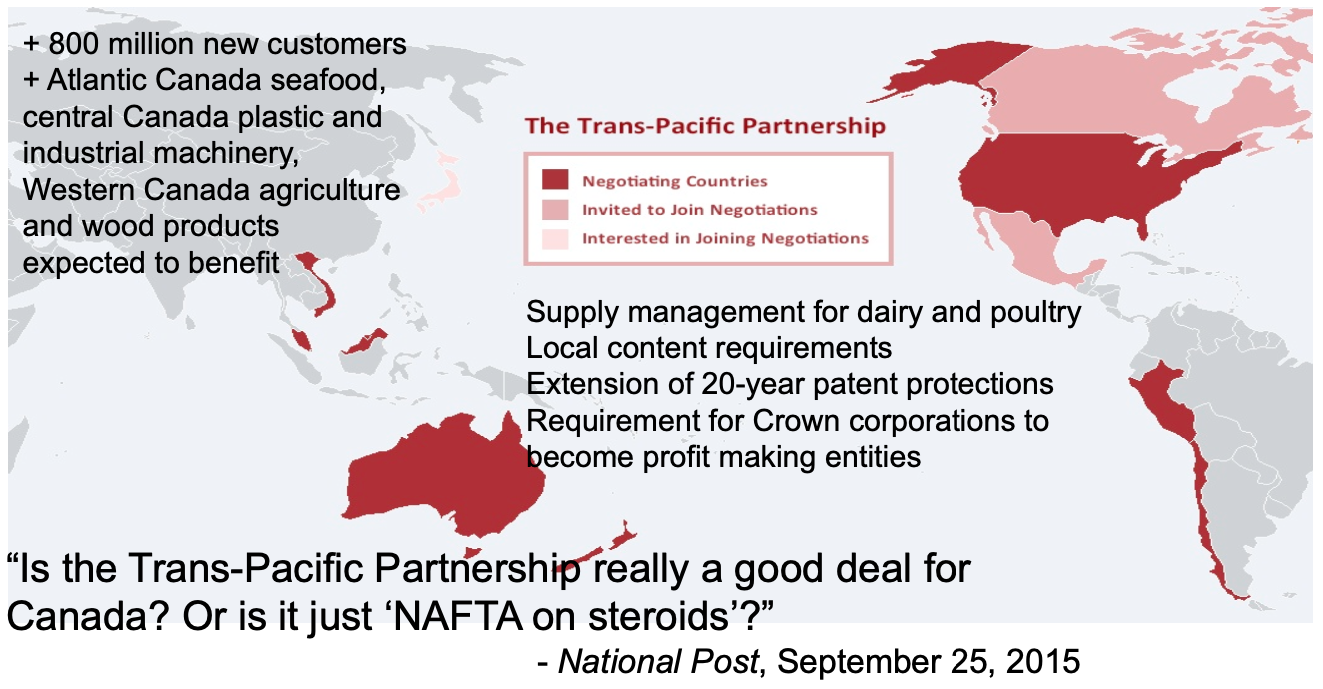
Is a mega-regional a building block?
The companion figure sketches how shifts in the regional policy environment alter subsidiary mandates and firm boundaries.
knitr::include_graphics("./figures/session5/fig6.png")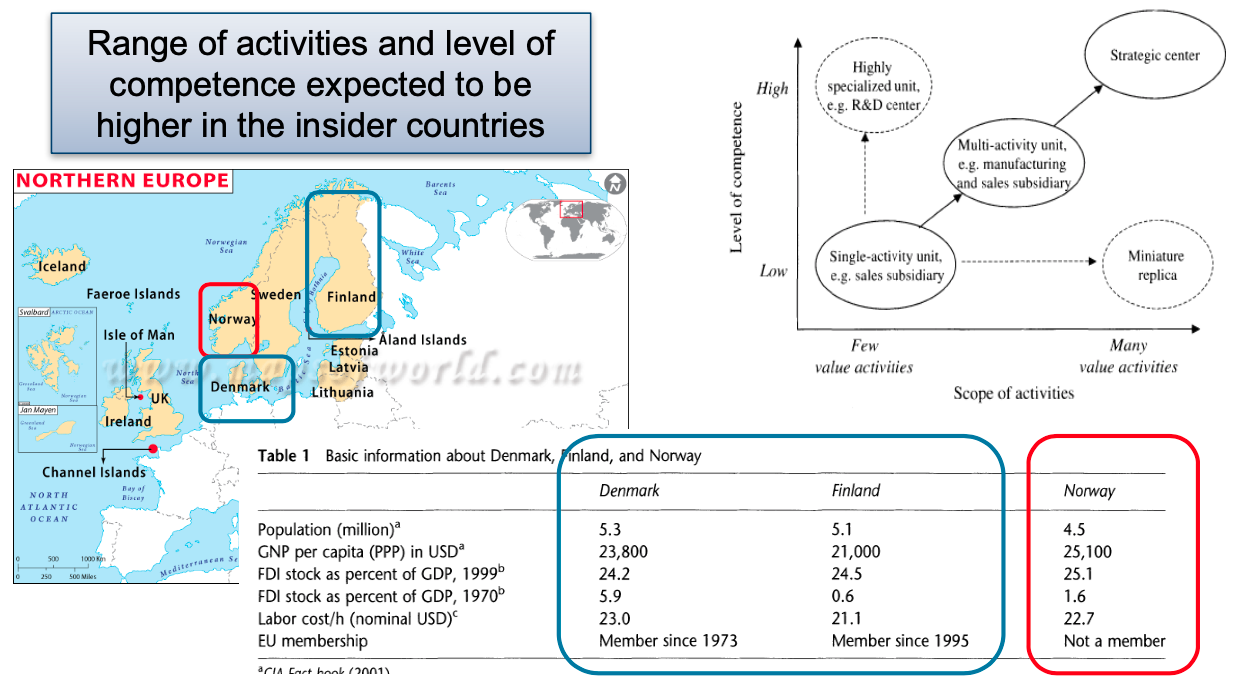
Environmental influences on subsidiary roles within MNE networks.
18.5 Multinationals, GVCs, and FDI: How RTAs Rewire Production
The “second unbundling” of globalization—the geographic separation of production stages—has made GVC participation sensitive to behind-the-border frictions (Baldwin, 2011). RTAs that credibly reduce policy uncertainty and standardize regulatory interfaces can therefore have outsized effects on firm organization, investment, and trade in intermediates (Antràs & Helpman, 2008; Antràs & Staiger, 2012). By embedding investment protections and services liberalization alongside tariff concessions, deep agreements alter the relative costs of exporting versus horizontal or vertical FDI, and they shape the margins through which firms serve foreign markets.
Empirically, the combination of deep provisions and generous cumulation tends to correlate with elevated trade in parts and components and with more complex sourcing patterns, particularly in manufacturing sectors with finely sliced value chains (Osnago et al., 2018; Mattoo et al., 2020). These effects are not mechanical: the realized reorganization of production depends on sectoral characteristics, initial conditions in domestic business environments, and the quality of implementation. Moreover, the distributive consequences are non-trivial. Regions with deep agreements may attract FDI disproportionately, while outsiders face erosion of preferences that induce them to seek entry or negotiate parallel accords (Baldwin, 1997; Dür et al., 2014).
The next sections use North America, Europe, Latin America, Asia, and Africa to illustrate these mechanisms in context.
18.6 North America: NAFTA’s Organization of Trade and the USMCA Update
North America offers a canonical case of deepening regional integration reshaping trade and production. The Canada–United States Free Trade Agreement (1988) initiated tariff elimination across a broad swath of goods; the North American Free Trade Agreement (NAFTA) extended liberalization to Mexico and added investment, services, and intellectual property provisions, while preserving the fundamental character of a free-trade area rather than a customs union. The agreement catalyzed regional value chains in automotive, electronics, and agrifood, with components crossing borders multiple times before final assembly (Lederman, Maloney, & Servén, 2005; Trefler, 2004).
A simple map situates the agreement.
library(ggplot2)
world <- map_data("world")
NAFTA.countries <- c("USA", "Canada", "Mexico")
NAFTA <- map_data("world", region = NAFTA.countries)
ggplot(NAFTA, aes(x = long, y = lat, group = group, fill = region)) +
geom_polygon(color = "black") +
coord_fixed(1.2, xlim = c(-175, -55)) +
theme_void() +
theme(legend.position = "bottom")
To illustrate macro trends, the figures below plot constant-dollar exports and imports of goods and services for the three signatories, marking 1994 as the entry into force of NAFTA. These descriptive series do not identify causal impacts; they simply contextualize the scale of reorientation.
library(WDI)
DataExport <- WDI(indicator='NE.EXP.GNFS.KD', country=c('MX','US','CA'), start=1960, end=2020)
# HTML interactive
if (knitr::is_html_output()) {
library(plotly)
fig_exports <- plot_ly(DataExport, x=~year, y=~NE.EXP.GNFS.KD,
color=~country, type='scatter', mode='lines') %>%
layout(title="Exports of Goods and Services",
xaxis=list(title="Year"),
yaxis=list(title="Exports (constant 2010 US$)"))
fig_exports
}
# PDF static
if (knitr::is_latex_output()) {
library(ggplot2)
ggplot(DataExport, aes(x = year, y = NE.EXP.GNFS.KD, color = country)) +
geom_line() +
theme_minimal() +
labs(x = "Year", y = "Exports (constant 2010 US$)",
title = "Exports of Goods and Services")
}DataImport <- WDI(indicator='NE.IMP.GNFS.KD', country=c('MX','US','CA'), start=1960, end=2020)
if (knitr::is_html_output()) {
fig_imports <- plot_ly(DataImport, x=~year, y=~NE.IMP.GNFS.KD,
color=~country, type='scatter', mode='lines') %>%
layout(title="Imports of Goods and Services",
xaxis=list(title="Year"),
yaxis=list(title="Imports (constant 2010 US$)"))
fig_imports
} else {
# Static plot for non-HTML output
library(ggplot2)
library(ggthemes)
library(ggsci)
ggplot(DataImport, aes(x = year, y = NE.IMP.GNFS.KD, color = country)) +
geom_line() +
xlab("Année") +
ylab("Importations de B&S (constant 2010 US$)") +
theme_hc() +
ggtitle("Importations de biens et services") +
geom_vline(xintercept = 1994, linetype = "dashed", linewidth = 0.5) +
geom_text(aes(x = 1994, label = "ALENA", y = 2.5e12), colour = "black", angle = 90, vjust = 1.2, size = 3)
}Do RTAs crowd in FDI? The literature on NAFTA’s first decade suggests that reduced policy uncertainty and investment disciplines supported inbound FDI regionwide, though distribution across countries and sectors was uneven (Feils & Rahman, 2008; Lederman et al., 2005). Micro-evidence for Canada finds significant productivity and wage effects associated with tariff cuts under CUFTA (Trefler, 2004). Mexico’s experience underscores the role of complementary domestic reforms and supply-side conditions in translating market access into investment outcomes (Lederman et al., 2005).
knitr::include_graphics("./figures/session5/fig7.png")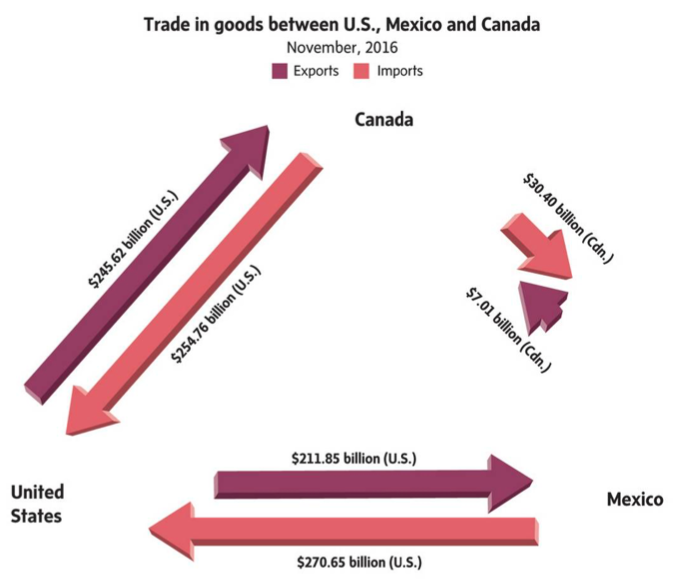
North American trade expansion after NAFTA.
knitr::include_graphics("./figures/session5/fig8.png")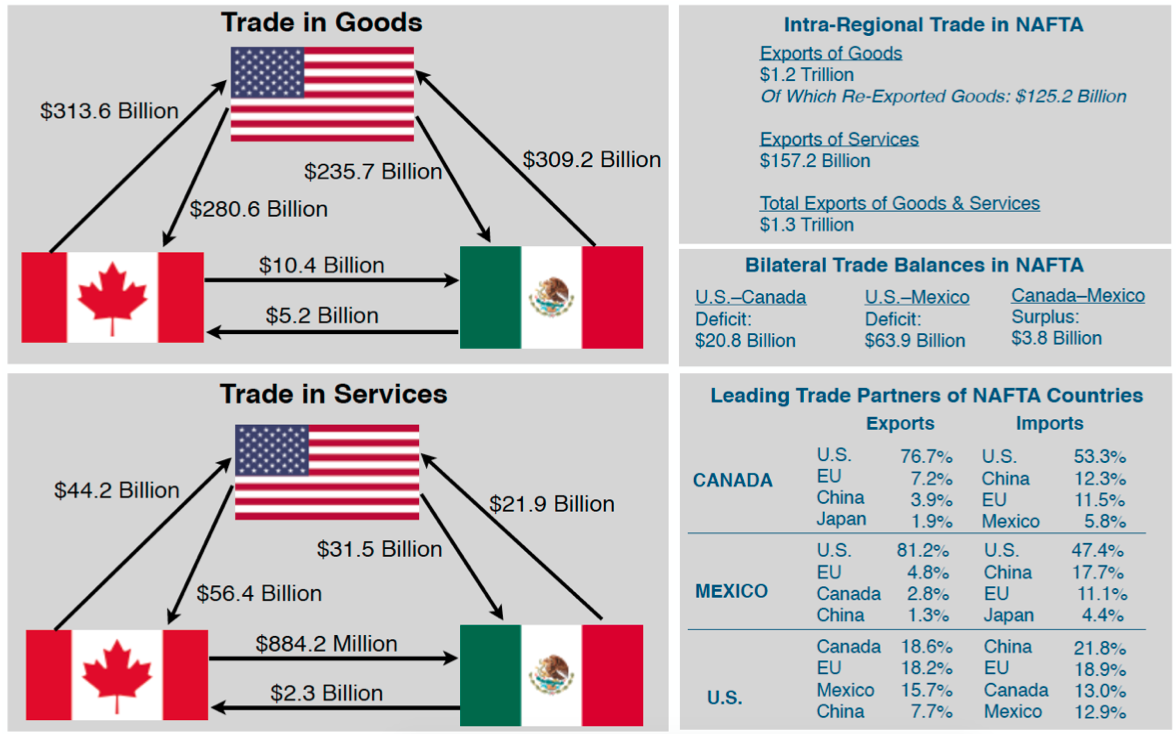
North American trade in global context.
knitr::include_graphics("./figures/session5/fig9.png")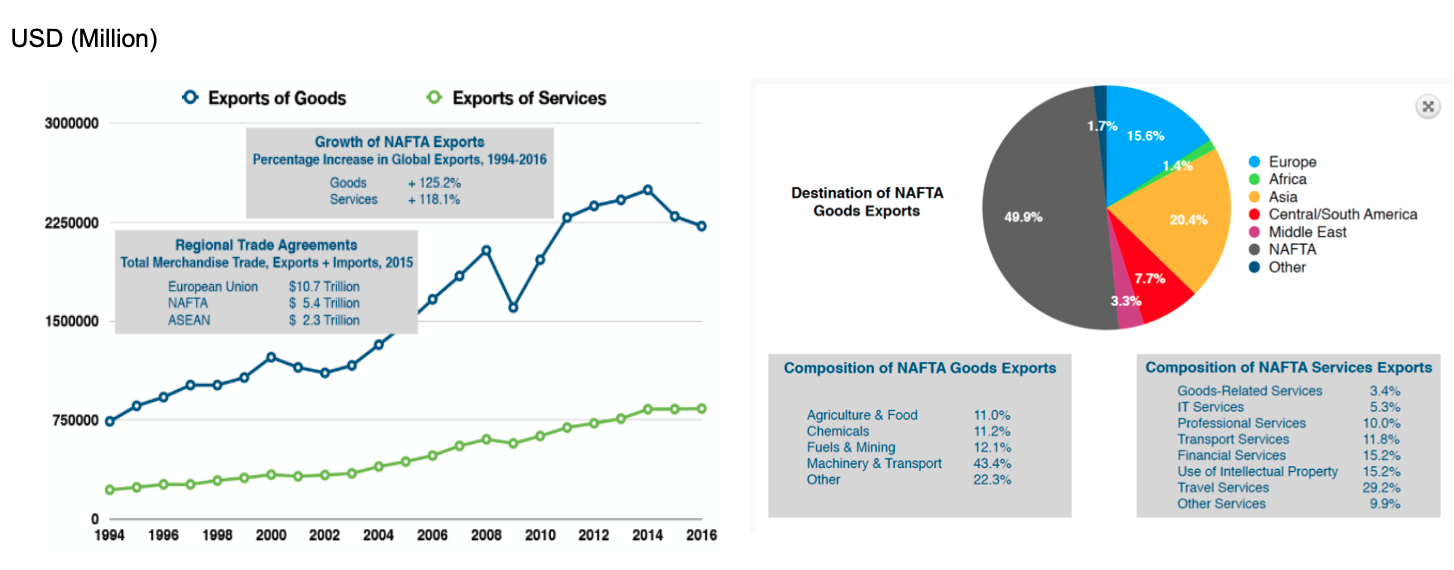
Shares of world trade: comparative blocs.
Firm-level decisions are also sensitive to national policy tools within a regional setting. Episodic relocations associated with export credit availability or sectoral support illustrate how national instruments can interact with RTA-level rules to shape location choice, even when market access is uniform across members. The figure below documents an illustrative case in which the presence or absence of export financing influenced plant siting within North America.
knitr::include_graphics("./figures/session5/fig10.png")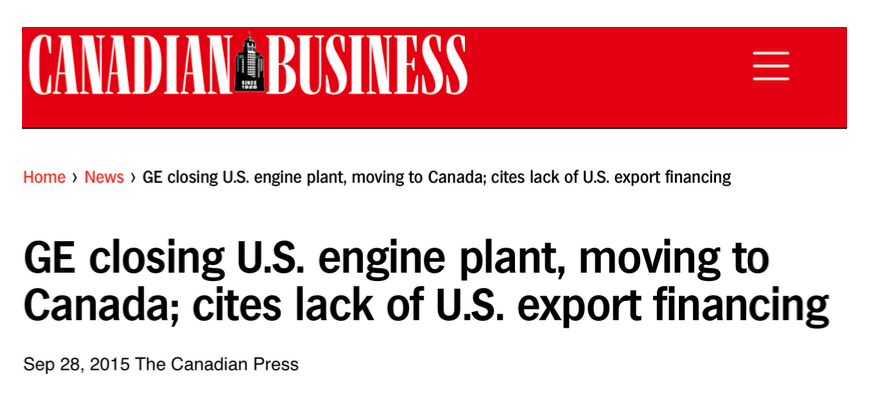
Illustrative case: national policy instruments within a regional market.
The 2020 United States–Mexico–Canada Agreement (USMCA) updated NAFTA’s template. It retained a trilateral free-trade area while revising rules in digital trade, labor, and environment and tightening automotive rules of origin by raising regional content thresholds and introducing a labor value content requirement. It also included a review clause, provisions affecting data localization, and disciplines on state-owned enterprises. Whether these changes reconfigure production will depend on firms’ compliance choices—meeting stricter ROOs or paying MFN tariffs—and on complementary domestic policies (Mattoo et al., 2020).
18.7 Europe: From Customs Union to Economic Union
European integration is the most advanced experiment in regionalism, progressing from a customs union to a single market and a monetary union for a subset of members. The European Union (EU) combines deep negative integration (removal of internal barriers) with positive integration (common rules and institutions), including an independent court and supranational decision-making in specified domains. Exclusive competencies include the common commercial policy and, for euro area members, monetary policy; shared and supporting competencies extend to myriad regulatory areas (Hoekman & Kostecki, 2009).
library(ggplot2)
world <- map_data("world")
# All countries in greater Europe region for map context
europe <- subset(world, region %in% c(
"Albania", "Andorra", "Armenia", "Austria", "Azerbaijan",
"Belarus", "Belgium", "Bosnia and Herzegovina", "Bulgaria",
"Croatia", "Cyprus", "Czech Republic", "Denmark", "Estonia", "Finland",
"France", "Georgia", "Germany", "Greece", "Hungary", "Iceland",
"Ireland", "Italy", "Kazakhstan", "Kosovo", "Latvia", "Liechtenstein",
"Lithuania", "Luxembourg", "Malta", "Moldova", "Monaco", "Montenegro",
"North Macedonia", "Netherlands", "Norway", "Poland", "Portugal", "Romania",
"Russia", "San Marino", "Serbia", "Slovakia", "Slovenia", "Spain",
"Sweden", "Switzerland", "Turkey", "Ukraine", "UK", "Vatican"))
# EU member countries (as of 2020) for highlighting
eu_members <- c("Austria","Belgium","Bulgaria","Croatia","Cyprus","Czech Republic",
"Denmark","Estonia","Finland","France","Germany","Greece",
"Hungary","Ireland","Italy","Latvia","Lithuania","Luxembourg",
"Malta","Netherlands","Poland","Portugal","Romania",
"Slovakia","Slovenia","Spain","Sweden")
european_union <- map_data("world", region = eu_members)
ggplot(data = europe, aes(x = long, y = lat, group = group)) +
geom_polygon(fill = "grey80", color = "black") +
geom_polygon(data = european_union, fill = "#f9fd7f", color = "black") +
theme_void() +
coord_fixed(ratio = 1.3, xlim = c(-30, 50), ylim = c(35, 72))
The EU’s internal market—free movement of goods, services, capital, and labor—has been complemented by external agreements of considerable depth with neighboring states (e.g., the European Economic Area) and by modern RTAs with partners across the world. The EU is thus both a regional project and a rule exporter. Its experience illustrates how institutional density, credible enforcement, and legislative capacity can support deep integration, albeit with nontrivial distributional and political challenges across diverse member states (Hoekman & Kostecki, 2009; Horn et al., 2010).
18.8 Latin America: From LAFTA/LAIA to MERCOSUR and Beyond
Latin American regionalism has evolved through waves. The early postwar response to European integration included the Latin American Free Trade Association (LAFTA, 1960), which sought a gradual free-trade area but fell short, and its successor, the more flexible Latin American Integration Association (LAIA, 1980), which allowed partial-scope agreements and differentiated obligations. The post–Cold War period witnessed renewed efforts, notably MERCOSUR (1991), which aimed to become a customs union and common market among Argentina, Brazil, Paraguay, and Uruguay (and later Venezuela, with a complex trajectory). These arrangements were motivated by both external shocks (e.g., preference erosion in Europe, perceived investment diversion to Eastern Europe) and internal goals (market enlargement, policy coordination) (Devlin & Estevadeordal, 2001).
The region’s experience underscores the importance of implementation capacity and macroeconomic stability for transforming paper commitments into integrated markets. Progress has been meaningful in tariff liberalization and, in some cases, in services and investment, but institutional fragility and asymmetric shocks have periodically impeded deeper convergence. The result is a dense but heterogeneous web of agreements, complementing unilateral and multilateral reforms.
18.9 Asia and the Pacific: Open Regionalism, ASEAN Centrality, and Mega-Regional Templates
Asian regionalism is distinctive in its flexibility and openness. The Association of Southeast Asian Nations (ASEAN) has deepened cooperation through the ASEAN Free Trade Area and the ASEAN Economic Community, while functioning as an institutional hub linking to partners via “ASEAN+1” agreements. The Asia-Pacific Economic Cooperation (APEC) forum has promoted voluntary liberalization, capacity building, and the idea of “open regionalism,” whereby preferences are extended non-discriminatorily (Ravenhill, 2010). More recently, large-scale templates have emerged, reflecting both the gravitational pull of major economies and the desire to stabilize rules for complex value chains.
library(ggplot2)
world <- map_data("world")
asean <- subset(world, region %in% c("Brunei", "Cambodia", "Indonesia", "Laos", "Malaysia", "Myanmar",
"Philippines", "Singapore", "Thailand", "Vietnam"))
# Highlight ASEAN in gold
ggplot() +
geom_polygon(data = asean, aes(x = long, y = lat, group = group), fill = "gold", color = "black") +
coord_fixed(1.0, xlim = c(90, 140), ylim = c(-10, 28)) +
theme_void()
library(ggplot2)
library(dplyr)
world <- map_data("world") %>% filter(region != "Antarctica")
apec_members <- c("USA", "Australia", "Brunei", "Canada", "Chile", "China", "Hong Kong",
"Indonesia", "Japan", "Malaysia", "Mexico", "New Zealand",
"Papua New Guinea", "Peru", "Philippines", "Russia", "Singapore",
"South Korea", "Taiwan", "Thailand", "Vietnam")
apec <- subset(world, region %in% apec_members)
ggplot() +
geom_polygon(data = world, aes(x = long, y = lat, group = group), fill = "grey85", color = "white", size = 0.2) +
geom_polygon(data = apec, aes(x = long, y = lat, group = group), fill = "darkgreen", color = "white", size = 0.2) +
coord_fixed(1.2) +
theme_void()
# Warning: Using `size` aesthetic for lines was deprecated in ggplot2 3.4.0.
# ℹ Please use `linewidth` instead.
The region’s RTAs have been instrumental in codifying investment and services disciplines relevant to GVC-intensive sectors such as electronics and automotive. The balance between hub-and-spoke agreements and broader, multi-member templates remains central to the trajectory of Asian integration, with implications for cumulation rules and the extent to which regional preferences can be multilateralized (Baldwin, 2011; Hofmann et al., 2017).
18.10 Africa: Multiple Communities, Overlaps, and the Quest for Continental Integration
African regionalism is characterized by a mosaic of overlapping communities with varied depth and scope, including the Common Market for Eastern and Southern Africa (COMESA), the Economic Community of Central African States (ECCAS), the Economic Community of West African States (ECOWAS), and the Arab Maghreb Union (AMU). These communities pursue tariff liberalization, customs unions, and policy coordination at different speeds, with implementation shaped by infrastructure constraints, institutional capacity, and the political economy of distribution (UNECA, 2016). The continental project to build a unified market has sought to rationalize overlaps and scale benefits.
library(ggplot2)
world <- map_data("world")
africa <- subset(world, region %in% c(
"Algeria","Angola","Benin","Botswana","Burkina Faso","Burundi",
"Cabo Verde","Cameroon","Central African Republic","Chad","Comoros",
"Democratic Republic of the Congo","Republic of Congo","Ivory Coast",
"Djibouti","Egypt","Equatorial Guinea","Eritrea","Eswatini","Ethiopia",
"Gabon","Gambia","Ghana","Guinea","Guinea-Bissau","Kenya","Lesotho",
"Liberia","Libya","Madagascar","Malawi","Mali","Mauritania","Mauritius",
"Morocco","Mozambique","Namibia","Niger","Nigeria","Rwanda",
"Sao Tome and Principe","Senegal","Seychelles","Sierra Leone","Somalia",
"South Africa","South Sudan","Sudan","Tanzania","Togo","Tunisia",
"Uganda","Zambia","Zimbabwe"))
comesa_members <- c("Burundi", "Comoros", "Democratic Republic of the Congo", "Djibouti",
"Egypt", "Eritrea","Ethiopia", "Kenya", "Libya", "Madagascar",
"Malawi", "Mauritius", "Rwanda", "Seychelles", "Sudan", "Eswatini",
"Uganda", "Zambia", "Zimbabwe")
comesa <- subset(world, region %in% comesa_members)
ggplot(data = africa, aes(x = long, y = lat, group = group)) +
geom_polygon(fill = "white", color = "black") +
geom_polygon(data = comesa, fill = "gray", color = "black") +
coord_fixed(1.0) +
theme_void()
library(ggplot2)
world <- map_data("world")
africa <- subset(world, region %in% c(
"Algeria","Angola","Benin","Botswana","Burkina Faso","Burundi",
"Cabo Verde","Cameroon","Central African Republic","Chad","Comoros",
"Democratic Republic of the Congo","Republic of Congo","Ivory Coast",
"Djibouti","Egypt","Equatorial Guinea","Eritrea","Eswatini","Ethiopia",
"Gabon","Gambia","Ghana","Guinea","Guinea-Bissau","Kenya","Lesotho",
"Liberia","Libya","Madagascar","Malawi","Mali","Mauritania","Mauritius",
"Morocco","Mozambique","Namibia","Niger","Nigeria","Rwanda",
"Sao Tome and Principe","Senegal","Seychelles","Sierra Leone","Somalia",
"South Africa","South Sudan","Sudan","Tanzania","Togo","Tunisia",
"Uganda","Zambia","Zimbabwe"))
eccas_members <- c("Angola", "Burundi", "Cameroon", "Central African Republic", "Chad",
"Democratic Republic of the Congo", "Equatorial Guinea", "Republic of Congo",
"Gabon", "Rwanda", "Sao Tome and Principe")
ECCAS_map <- subset(world, region %in% eccas_members)
ggplot(data = africa, aes(x = long, y = lat, group = group)) +
geom_polygon(fill = "white", color = "black") +
geom_polygon(data = ECCAS_map, fill = "gray", color = "black") +
coord_fixed(1.0) +
theme_void()
library(ggplot2)
world <- map_data("world")
africa <- subset(world, region %in% c(
"Algeria","Angola","Benin","Botswana","Burkina Faso","Burundi",
"Cabo Verde","Cameroon","Central African Republic","Chad","Comoros",
"Democratic Republic of the Congo","Republic of Congo","Ivory Coast",
"Djibouti","Egypt","Equatorial Guinea","Eritrea","Eswatini","Ethiopia",
"Gabon","Gambia","Ghana","Guinea","Guinea-Bissau","Kenya","Lesotho",
"Liberia","Libya","Madagascar","Malawi","Mali","Mauritania","Mauritius",
"Morocco","Mozambique","Namibia","Niger","Nigeria","Rwanda",
"Sao Tome and Principe","Senegal","Seychelles","Sierra Leone","Somalia",
"South Africa","South Sudan","Sudan","Tanzania","Togo","Tunisia",
"Uganda","Zambia","Zimbabwe"))
ecowas_members <- c("Benin", "Burkina Faso", "Cabo Verde", "Ivory Coast", "Gambia",
"Ghana", "Guinea", "Guinea-Bissau", "Liberia", "Mali",
"Mauritania", "Niger", "Nigeria", "Senegal", "Sierra Leone", "Togo")
ECOWAS_map <- subset(world, region %in% ecowas_members)
ggplot(data = africa, aes(x = long, y = lat, group = group)) +
geom_polygon(fill = "white", color = "black") +
geom_polygon(data = ECOWAS_map, fill = "gray", color = "black") +
coord_fixed(1.0) +
theme_void()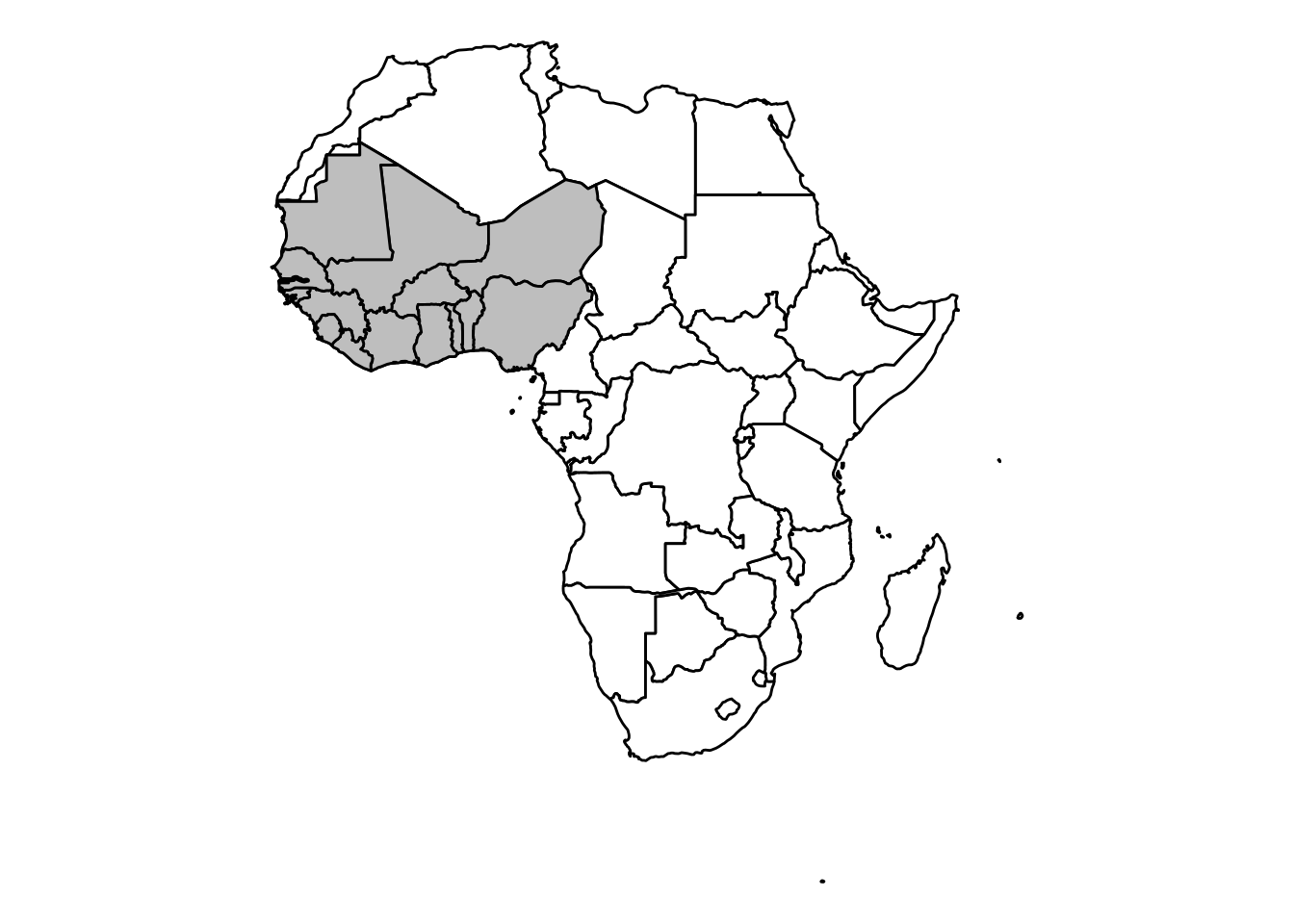
library(ggplot2)
world <- map_data("world")
africa <- subset(world, region %in% c(
"Algeria","Angola","Benin","Botswana","Burkina Faso","Burundi",
"Cabo Verde","Cameroon","Central African Republic","Chad","Comoros",
"Democratic Republic of the Congo","Republic of Congo","Ivory Coast",
"Djibouti","Egypt","Equatorial Guinea","Eritrea","Eswatini","Ethiopia",
"Gabon","Gambia","Ghana","Guinea","Guinea-Bissau","Kenya","Lesotho",
"Liberia","Libya","Madagascar","Malawi","Mali","Mauritania","Mauritius",
"Morocco","Mozambique","Namibia","Niger","Nigeria","Rwanda",
"Sao Tome and Principe","Senegal","Seychelles","Sierra Leone","Somalia",
"South Africa","South Sudan","Sudan","Tanzania","Togo","Tunisia",
"Uganda","Zambia","Zimbabwe"))
amu_members <- c("Algeria", "Libya", "Mauritania", "Morocco", "Tunisia")
AMU_map <- subset(world, region %in% amu_members)
ggplot(data = africa, aes(x = long, y = lat, group = group)) +
geom_polygon(fill = "white", color = "black") +
geom_polygon(data = AMU_map, fill = "gray", color = "black") +
coord_fixed(1.0) +
theme_void()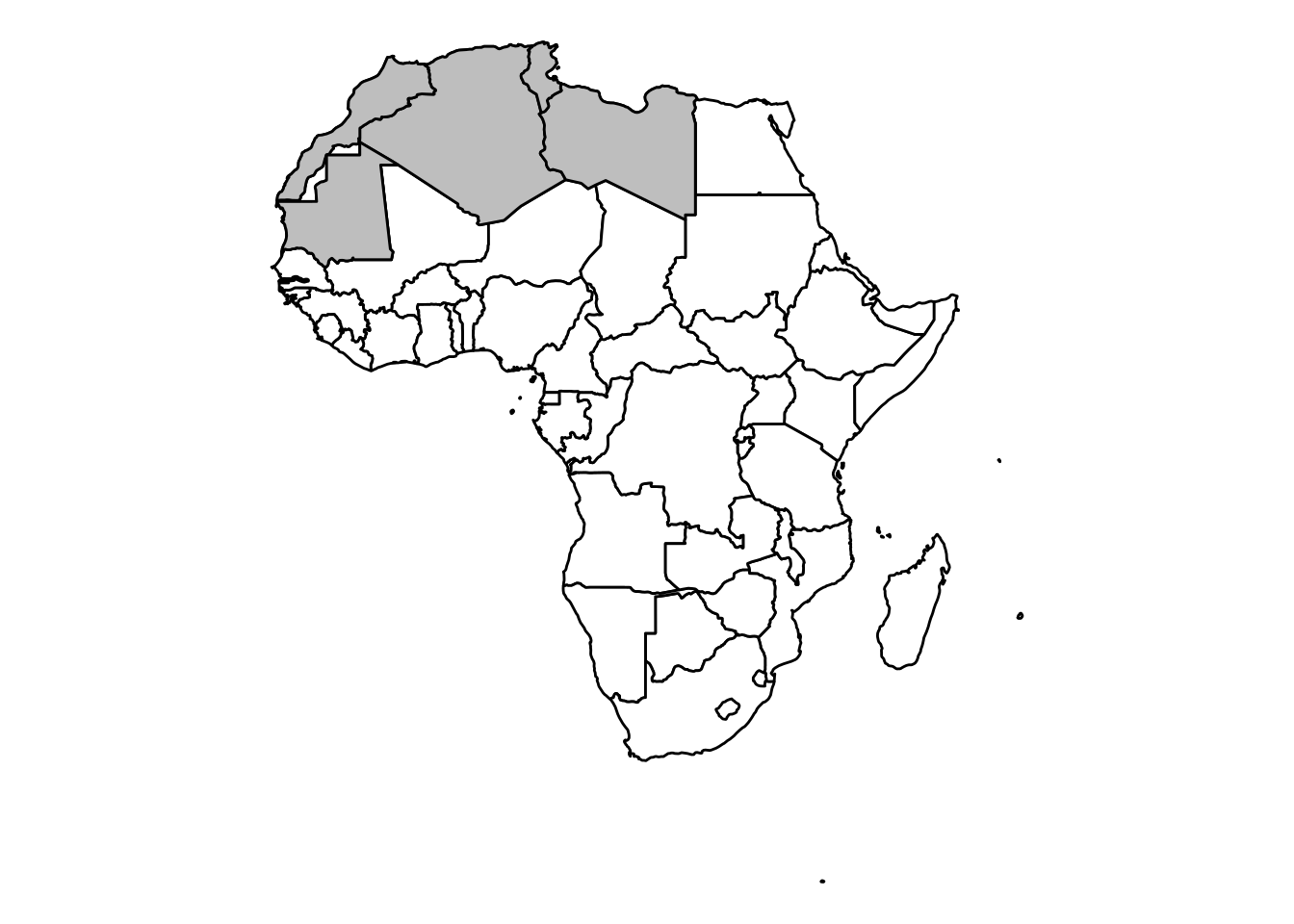
African integration illustrates both the promise and the complexity of regionalism in development contexts: when infrastructure and institutions bind, regional markets expand and investment follows; when overlaps and implementation gaps persist, the costs of fragmentation fall disproportionately on small firms and landlocked economies (UNECA, 2016). These features make the legal design of cumulation, trade facilitation, and regulatory cooperation particularly salient.
18.11 Regionalization within Globalization: Conceptual Synthesis
Regionalization should be understood as one layer of governance in a stratified global economy. De jure regionalism—codified in RTAs and institutions—interacts with de facto regionalization driven by firms’ networks, migrant remittances, and information flows (Baldwin, 2011; Ravenhill, 2010). The resulting cartography is not a clean partition into distinct blocs but rather a multiplex system where overlapping jurisdictions govern different policy domains and where private standards frequently accompany public rules (Dür et al., 2014; Mattoo et al., 2020).
Against this backdrop, several conceptual points clarify how RTAs and the WTO can be complementary. First, when deep RTAs supply rules that are infeasible to negotiate multilaterally, they can act as laboratories that, over time, diffuse to the multilateral level—a dynamic documented for norms in procurement, competition cooperation, or paperless trade (Baldwin & Low, 2009; Hoekman & Mavroidis, 2015). Second, where RTAs create rents through restrictive ROOs or carve-outs, transparency disciplines and multilateral surveillance can mitigate adverse spillovers (WTO, 2011). Third, plurilateral cooperation under the WTO umbrella (e.g., on services or e-commerce) provides a pathway to multilateralize regional disciplines without requiring unanimity (Hoekman & Mavroidis, 2015).
Finally, the developmental implications of regionalism hinge on design. Preferences for least developed countries via the GSP, special and differential treatment provisions, and aid-for-trade initiatives can be—and increasingly are—embedded alongside RTAs to reduce fixed costs of compliance for small firms and to prevent preference erosion from undermining export diversification (Hoekman & Kostecki, 2009; WTO, 2011). Where regionalism is crafted as an instrument of outward orientation, it can be reconciled with MFN and multilateral disciplines.
18.12 Conclusion
The WTO’s core commitments of MFN and national treatment remain the backbone of the world trading system, yet the rise of regional trade agreements has fundamentally reconfigured the channels through which liberalization and rule-making proceed. The legal architecture is deliberately permissive but conditional: RTAs are allowed to deviate from MFN provided they cover substantially all trade and do not, on balance, increase barriers against third parties. The empirical record shows that regionalism has been expansive, heterogeneous, and increasingly deep. Its welfare and systemic effects depend on design choices—scope, ROOs, cumulation, transparency, and enforcement—and on the political economy of implementation.
Two pragmatic principles emerge. First, to the extent RTAs are outward-oriented, comprehensive, and equipped with cumulation and facilitation rules aligned to value chains, they tend to function as building blocks that can eventually be multilateralized. Second, transparency and multilateral oversight are essential to discipline the spaghetti bowl and to ensure that preferences do not ossify into exclusionary club goods. The multilateral and regional logics are not inherently antagonistic; their complementarity depends on how states choose to write, enforce, and connect their trade rules. For teachers and practitioners in IPE, the appropriate stance is neither celebration nor condemnation of regionalism per se, but careful attention to institutional craft and political economy dynamics that determine whether regional integration fosters or fragments the global trade regime (Freund & Ornelas, 2010; Hoekman & Mavroidis, 2015; Mattoo et al., 2020).
References
Antràs, P., & Helpman, E. (2008). Contractual frictions and global sourcing. In E. Helpman, D. Marin, & T. Verdier (Eds.), The organization of firms in a global economy (pp. 9–54). Harvard University Press.
Antràs, P., & Staiger, R. W. (2012). Offshoring and the role of trade agreements. American Economic Review, 102(7), 3140–3183.
Baccini, L., Dür, A., & Elsig, M. (2017). Intra-industry trade, global value chains, and preferential tariff liberalization. International Studies Quarterly, 61(2), 329–342.
Bagwell, K., & Staiger, R. W. (2002). The economics of the world trading system. MIT Press.
Baldwin, R. (1997). The causes of regionalism. The World Economy, 20(7), 865–888.
Baldwin, R. (2011). 21st century regionalism: Filling the gap between 21st century trade and 20th century trade rules. World Trade Review, 10(1), 1–14.
Baldwin, R., & Low, P. (Eds.). (2009). Multilateralizing regionalism: Challenges for the global trading system. Cambridge University Press.
Bhagwati, J. (1993). Regionalism and multilateralism: An overview. In J. de Melo & A. Panagariya (Eds.), New dimensions in regional integration (pp. 22–51). Cambridge University Press.
Bhagwati, J. (1995). US trade policy: The infatuation with FTAs. In J. Bhagwati & A. O. Krueger (Eds.), The dangerous drift to preferential trade agreements. AEI Press.
Cadot, O., & de Melo, J. (2008). Why OECD countries should reform rules of origin. The World Bank Research Observer, 23(1), 77–105.
Devlin, R., & Estevadeordal, A. (2001). What’s new in the new regionalism in the Americas? Integration & Trade, 6(15), 17–35.
Dür, A., Baccini, L., & Elsig, M. (2014). The design of international trade agreements: Introducing a new dataset. The Review of International Organizations, 9(3), 353–375.
Eicher, T. S., & Henn, C. (2011). In search of WTO trade effects: Preferential trade agreements promote trade strongly, but unevenly. Journal of International Economics, 83(2), 137–153.
Estevadeordal, A., & Suominen, K. (2008). Gatekeepers of globalization: Rules of origin and international economic integration. Inter-American Development Bank.
Ethier, W. (1998). The new regionalism. The Economic Journal, 108(449), 1149–1161.
Feils, D., & Rahman, M. (2008). Regional economic integration and foreign direct investment: The case of NAFTA. Management International Review, 48(2), 147–163.
Freund, C., & Ornelas, E. (2010). Regional trade agreements. Annual Review of Economics, 2(1), 139–166.
Head, K., & Mayer, T. (2014). Gravity equations: Workhorse, toolkit, and cookbook. In G. Gopinath, E. Helpman, & K. Rogoff (Eds.), Handbook of international economics (Vol. 4, pp. 131–195). Elsevier.
Hoekman, B., & Kostecki, M. (2009). The political economy of the world trading system (3rd ed.). Oxford University Press.
Hoekman, B., & Mavroidis, P. C. (2015). WTO ‘a la carte’ or ‘menu du jour’? Assessing plurilateral agreements. European Journal of International Law, 26(2), 319–343.
Hofmann, C., Osnago, A., & Ruta, M. (2017). Horizontal depth: A new database on the content of preferential trade agreements. Policy Research Working Paper 7981, World Bank.
Horn, H., Mavroidis, P. C., & Sapir, A. (2010). Beyond the WTO? An anatomy of EU and US preferential trade agreements. The World Economy, 33(11), 1565–1588.
Jackson, J. H. (1997). The world trading system: Law and policy of international economic relations (2nd ed.). MIT Press.
Krugman, P. (1991). Is bilateralism bad? In E. Helpman & A. Razin (Eds.), International trade and trade policy (pp. 9–23). MIT Press.
Lederman, D., Maloney, W., & Servén, L. (2005). Lessons from NAFTA for Latin America and the Caribbean. World Bank.
Limão, N. (2006). Preferential trade agreements as stumbling blocks for multilateral trade liberalization: Evidence for the US. American Economic Review, 96(3), 896–914.
Mattoo, A., Rocha, N., & Ruta, M. (2020). Handbook of deep trade agreements. World Bank.
Osnago, A., Rocha, N., & Ruta, M. (2018). Deep trade agreements and vertical FDI: The devil is in the details. Canadian Journal of Economics, 51(4), 1501–1538.
Ravenhill, J. (2010). The “new East Asian regionalism”: A political domino effect. Review of International Political Economy, 17(2), 178–208.
Rose, A. K. (2004). Do we really know that the WTO increases trade? American Economic Review, 94(1), 98–114.
Subramanian, A., & Wei, S.-J. (2007). The WTO promotes trade, strongly but unevenly. Journal of International Economics, 72(1), 151–175.
Trefler, D. (2004). The long and short of the Canada–US free trade agreement. American Economic Review, 94(4), 870–895.
UNECA. (2016). Assessing regional integration in Africa VII: Innovation, competitiveness and regional integration. United Nations Economic Commission for Africa.
Viner, J. (1950). The customs union issue. Carnegie Endowment.
WTO. (2011). World Trade Report 2011: The WTO and preferential trade agreements—From co-existence to coherence. World Trade Organization.